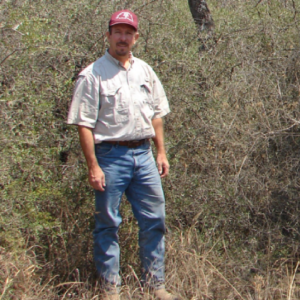Jim Ansley
Get to know the fire community
Jim Ansley, Professor and Regents Fellow with Texas A&M AgriLife Research-Vernon, Texas.
We’ll start with Butch Taylor’s question to you: Despite years of accumulating scientific evidence that fire is critical to the structure and function of Great Plains grasslands, society has been unable to restore fire as a fundamental grassland process across broad landscapes. What can be done to resolve this issue?
My feeling is that not much can be done. I think prescribed fire will play a minor role in grassland function but human population growth and urban, suburban and rural development (e.g., fences, structures, etc.), pressures to maintain cattle herds and graze and possibly climate change with increasing droughts will increasingly limit fire opportunities.
How did you get started working with fire and grassland systems?
I began fire research as a post-doctorate working with Dr. Pete Jacoby at Texas A&M AgriLife Vernon. We both had experience with brush control with chemical applications but began exploring the use of fire together.
What fire topics related to grasslands get you most excited as a researcher, and why?
The interaction of woody species and grasses and how fire affects those interactions.
What are the most important fire-related questions we need to answer for grasslands today?
Can fire really suppress or eliminate encroaching woody plants on large, regional scales; how frequently can prescribed fires realistically be applied on working ranches; Is there a disconnect between historical fire regimes that maintained a grassland state vs. thinking that we can mimic this using prescribed burning in an environment of more-or-less continual livestock grazing with only occasional deferment for prescribed fires.
Can you describe one or two findings/accomplishments that you are proud of from your career related to grasslands and fire?
(1) C4 midgrass restoration using summer season and alternate season fires; (2) mesquite seedling mortality response to fire intensity and summer fires.
Looking back over your career, can you offer some professional wisdom to those who are now getting their feet wet?
Make sure you understand all the legal ramifications before conducting a prescribed fire; do some practice burns on small areas to get a feel for wind effects and communication dynamics before taking on anything large; start with flat surfaces and slowly work up to understanding wind dynamics around hills and slopes; for research, replicate if possible and record as much about pre-fire conditions and conditions of the fire itself that you can include in publications; also when writing papers be careful not to compare your work to results from other fire studies that really don’t relate to the conditions of your study as support for your results – they can often be meaningless (e.g., comparing Yellowstone fire effects on soil nutrients to soils responses to a small plot grassland fire in west Texas).


